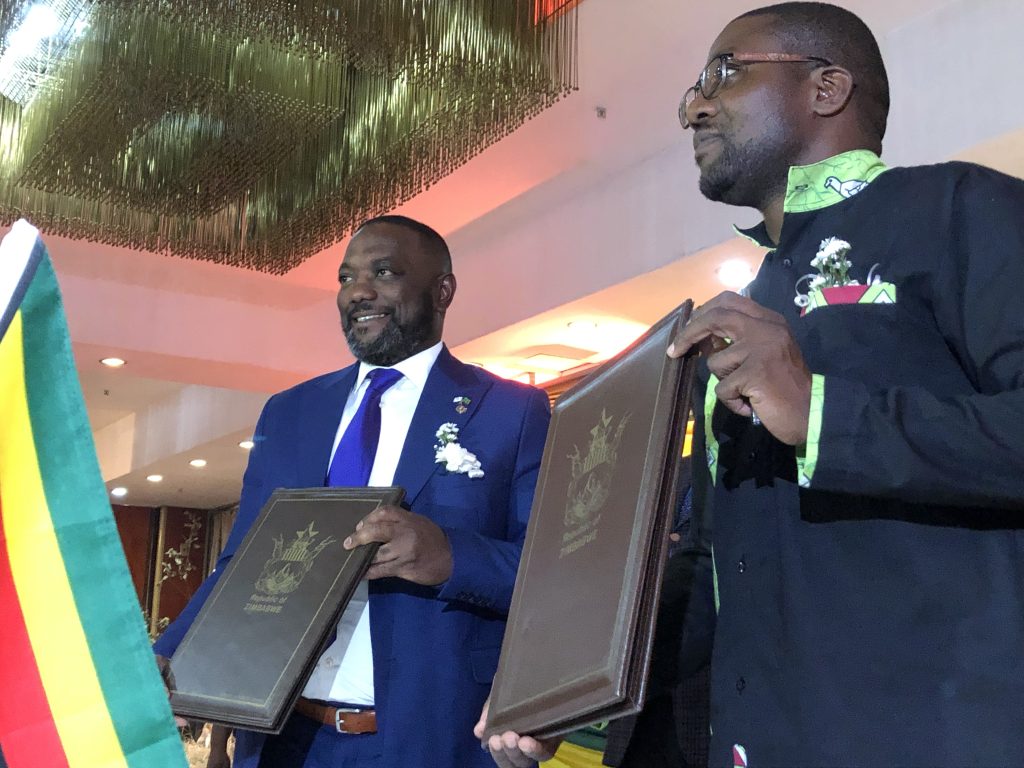John Cassim

Zimbabwe and Zambian Ministers Mangaliso Ndlovu and Rodney Sikumba, after signing the LOZAMAP TFCA MoU in Harare.
Harare, Zimbabwe – Zambia and Zimbabwe have established the Lower Zambezi-Mana Pools (LOZAMAP) TransFrontier Conservation Area (TFCA) after signing an MoU.
The approach a few weeks ago by these two governments is meant to promote regional biodiversity conservation and tourism development.
The TFCA approach was initiated because of the need to better manage shared resources; the drive for economic growth through regional integration and development; and the need to promote peace and security; among others.
LOZAMAP is located within the Zambezi Valley and encompasses Lower Zambezi National Park in Zambia and Mana Pools National Park and the surrounding safari areas of Zimbabwe.
– What is a TFCA?
A Trans-frontier Conservation Area (TFCA) is a region that straddles the borders of two or more countries, where natural and cultural resources are managed collaboratively by the governments and/or authorities involved.
TFCAs are a conservation concept that arose in response to the management challenges posed by fragmented ecosystems clustered along international boundaries and disrupted traditional migration routes caused by arbitrary political boundaries.
– GEF & UNDP involvement
With US$ 300 000 worth of funding from the Global Environment Facility (GEF), UNDP and the Zimbabwe Ministry of Environment, Climate, Tourism and Hospitality Industry, will support the establishment of a co-management arrangement between the two countries to promote the conservation of the TFCA.
The project titled “Strengthening Biodiversity and Ecosystems Management and Climate-Smart Landscapes in the Mid to Lower Zambezi Region of Zimbabwe”, also known as the “Zambezi Valley Biodiversity Project (ZVBP)” will mitigate development challenges associated with biodiversity loss, ecosystem degradation, and climate change consequences
Some of the challenges to be addressed include, poaching and illegal wildlife trade, human wildlife conflicts and retaliatory killings, deforestation, and climate change consequences (droughts, floods, increased frequency of veld fires) in the Mid to Lower Zambezi Area of Zimbabwe.
– structure of the ZVBP
The Project has four components, and these are:
1. Strengthening capacity and governance frameworks for integrated wildlife and forest management and wildlife and forest crime enforcement in Zimbabwe.
2. Strengthening Zimbabwe’s Project Area estate and CAMPFIRE Wildlife Conservancies in areas of global Biodiversity significance.
3. Mainstreaming Biodiversity and Ecosystems management, and climate change mitigation, into the wider landscape.
4. Knowledge Management, M&E and Gender Mainstreaming.
The ZVBP is being implemented under the National Implementation Modality
(NIM) through which the MECTHI is the Implementing Partner (IP).
There are three entities (Responsible Parties), that have been selected to act on behalf of the IP, to directly implement the project, and work with project partners and local communities in delivering relevant project outputs.
The Responsible Parties are Zimbabwe Parks and Wildlife Management Authority (ZimParks), CAMPFIRE Association and Forestry Commission.
– LOZAMAP background
The signing of an MoU recently to establish the LOZAMAP came backed with the US$ 300 000 by the GEF and managed by UNDP while riding on the 2018 – 2024 biodiversity initiative between the two countries, worth US$ 12 million.
The Lower Zambezi Mana Pools TransFrontier Conservation Area lies in the Zambezi Valley, which since the dawn of time has been used by wildlife as thoroughfare between the escarpment and the Zambezi valley.
The two national parks lying opposite each other make for a massive wildlife sanctuary on both sides of the mighty river.
The LOZAMAP TFCA is 17 745 square meters and is composed of the Lower Zambezi National Park which is 4 092 square meters in Zambia, and the Mana Pools National Park and World Heritage Site (2 196 square meters) in northern Zimbabwe.
The landscape of Mana Pools National Park, Sapi Safari area (1 180 square meters) and Chewore Safari Area (3 390 square meters) is a World Heritage Site inscribed on the list of world heritage property in 1984 under the UNESCO World Heritage Convention.
– TCFA for Zimbabwe & neighbours
1. ZIMOZA TFCA which consists of four districts, which are Mbire in Zimbabwe, Zumbo, and Magoe in Mozambique, and Luangwa in Zambia
2. Chimanimani TFCA in the Chimanimani Mountains established in 2001
3. Kavango Zambezi (KAZA) Transfrontier Conservation Area (TFCA) – Angola, Botswana, Namibia, Zambia and Zimbabwe
4. Great Limpopo TFCA – Mozambique, South Africa and Zimbabwe.
5. Limpopo/Shashe TFCA – Botswana and Zimbabwe

How about the track record of all other TFCAs listed above. A comment or two should have followed after the iteration of these TFCAs.
thank you for the comment its noted